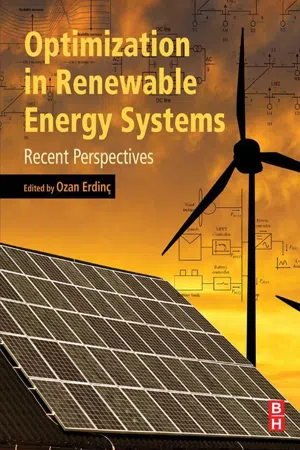
- 326 pages
- English
- ePUB (mobile friendly)
- Available on iOS & Android
About this book
Optimization in Renewable Energy Systems: Recent Perspectives covers all major areas where optimization techniques have been applied to reduce uncertainty or improve results in renewable energy systems (RES).Production of power with RES is highly variable and unpredictable, leading to the need for optimization-based planning and operation in order to maximize economies while sustaining performance.This self-contained book begins with an introduction to optimization, then covers a wide range of applications in both large and small scale operations, including optimum operation of electric power systems with large penetration of RES, power forecasting, transmission system planning, and DG sizing and siting for distribution and end-user premises.This book is an excellent choice for energy engineers, researchers, system operators, system regulators, and graduate students.- Provides chapters written by experts in the field- Goes beyond forecasting to apply optimization techniques to a wide variety of renewable energy system issues, from large scale to relatively small scale systems- Provides accompanying computer code for related chapters
Frequently asked questions
- Essential is ideal for learners and professionals who enjoy exploring a wide range of subjects. Access the Essential Library with 800,000+ trusted titles and best-sellers across business, personal growth, and the humanities. Includes unlimited reading time and Standard Read Aloud voice.
- Complete: Perfect for advanced learners and researchers needing full, unrestricted access. Unlock 1.4M+ books across hundreds of subjects, including academic and specialized titles. The Complete Plan also includes advanced features like Premium Read Aloud and Research Assistant.
Please note we cannot support devices running on iOS 13 and Android 7 or earlier. Learn more about using the app.
Information
Introduction to Renewable Energy Systems
Abstract
Keywords
1.1 An Overview of Renewable Energy Systems

1.1.1 Climate Change
Table of contents
- Cover image
- Title page
- Table of Contents
- Copyright
- List of Contributors
- Chapter 1. Introduction to Renewable Energy Systems
- Chapter 2. Introduction to Optimization
- Chapter 3. Optimal Procurement of Contingency and Load Following Reserves by Demand Side Resources Under Wind-Power Generation Uncertainty
- Chapter 4. Optimum Bidding of Renewable Energy System Owners in Electricity Markets
- Chapter 5. Impacts of Accurate Renewable Power Forecasting on Optimum Operation of Power System
- Chapter 6. Optimum Transmission System Expansion Offshore Considering Renewable Energy Sources
- Chapter 7. Optimum Sizing and Siting of Renewable-Energy-based DG Units in Distribution Systems
- Chapter 8. Optimum Design of Small-Scale Stand-Alone Hybrid Renewable Energy Systems
- Index